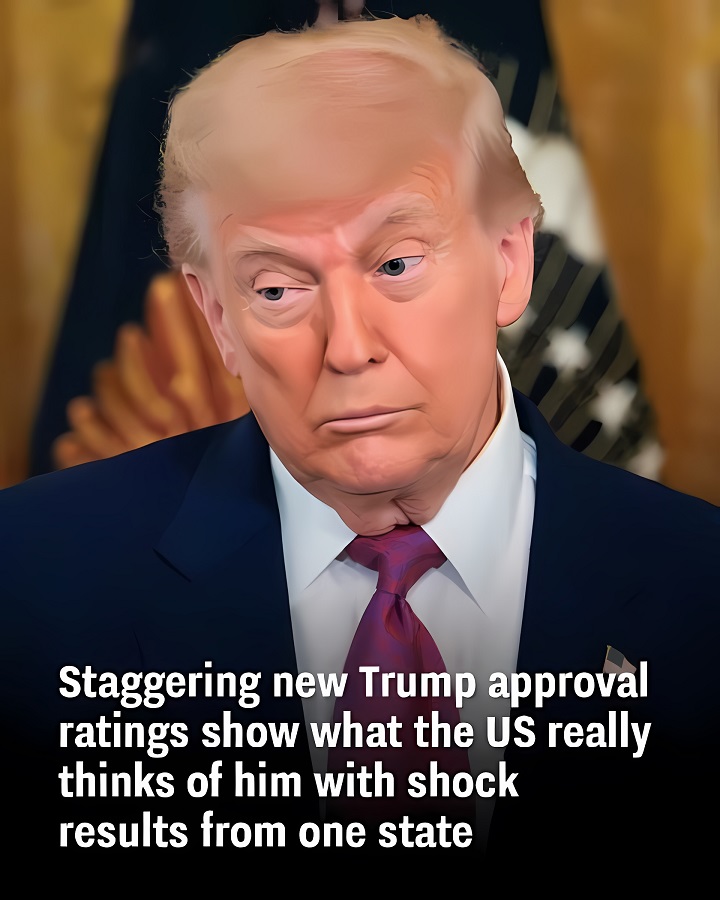President Donald Trump is facing a growing set of political challenges only months into his second term. Fresh polling data paints a more complex picture of public opinion as his approval ratings slip, economic concerns rise, and international tensions intensify.
For the first time in years, traditionally solid Republican territory is beginning to show signs of vulnerability—a trend that could spell trouble as the nation nears the 2026 midterms.
Trump’s Approval Rating Falls Below 50%
According to a recent survey conducted earlier this month, just 45% of Americans approve of Trump’s job performance—down from 49% in January. Meanwhile, 46% disapprove, and 9% remain uncertain. This represents a notable dip in support, especially considering Trump’s highly polarized presidency. As his disapproval now outpaces approval, questions arise about his broader national support in the lead-up to the 2026 elections.
Though the drop may seem modest, it signals a deeper unease among voters, especially as economic pressures and political divisions weigh heavily on the public.
A Divided Nation: The Road Ahead for Trump
A striking 53% of Americans believe the nation is heading in the wrong direction, while just 48% think the U.S. is on the right track, according to an Emerson College poll. This sharp division reflects a widening rift in the country, and could prove challenging for politicians, especially incumbents like Trump, seeking to expand their support beyond their core base.

Spencer Kimball, director of Emerson’s polling, highlighted a significant shift: Independent voters are now more likely to back Democratic congressional candidates (37%) over Republicans (27%), with 36% still undecided. This growing split could have major implications as both parties gear up for a fierce battle in the coming years.
Is Trump Losing Ground in Texas?
Texas—a state long regarded as a Republican stronghold—has revealed a startling trend. A new poll by the Texas Politics Project and the University of Texas shows only 44% of Texans approve of Trump’s performance, while 51% disapprove. This is a sharp contrast to Trump’s overwhelming victories in the state during both the 2016 and 2020 elections.
Texans’ dissatisfaction appears rooted in economic concerns. A significant 51% disagree with Trump’s handling of the economy, while 52% are unhappy with his approach to inflation and the rising cost of living. Even among Texas Republicans, support for Trump has dropped slightly, from 89% in April to 87%. While the decline may not seem drastic, it contributes to a broader trend of diminishing enthusiasm for his leadership.
Global Spotlight: Trump’s Role in the Iran-Israel Ceasefire
All of these domestic shifts come at a time when international tensions are adding new complexities to Trump’s political landscape. Earlier this month, Trump escalated tensions in the Middle East by ordering airstrikes on Iranian nuclear sites. Iran retaliated by attacking American military installations in Iraq and Qatar.
In a move that echoed his approach during his first term, Trump simultaneously positioned himself as both an aggressor and a peacemaker, mediating a temporary ceasefire between Iran and Israel amid fears of a broader conflict.
Trump’s unorthodox comments on the matter, where he boasted about American missile defenses and downplayed the seriousness of the situation, drew mixed reactions. Supporters praised his assertive diplomacy and the success of U.S. defense systems, while critics felt he minimized the gravity of the ongoing crisis.
A Base That Stays Loyal
Despite waning approval from the broader public, Trump continues to maintain strong backing from his core Republican supporters. More than 80% of GOP voters remain behind him, particularly on issues like immigration, national security, and law enforcement.
This unwavering support has become a lifeline for Trump as he navigates rising discontent among moderates and independents. For now, his base appears more entrenched than ever, offering him a solid foundation as Democrats make gains and the economy remains unpredictable.
The Road Ahead: 2026 and Beyond
As the 2026 midterm elections draw closer, Trump’s approval ratings will be a key bellwether for the political climate across the country. In states that the GOP has long relied on—like Florida, Arizona, and even Texas—the party may face unforeseen challenges if economic woes continue and independents shift further toward the Democratic side.
However, in politics, nothing is set in stone. A strong economic recovery, a key policy victory, or a major diplomatic win could quickly turn the tide in Trump’s favor.
Trump has weathered political storms before, but with rising inflation, growing concerns about global conflicts, and a fractured electorate, the question remains: will his hold on the narrative prove enough to secure his future in the political arena?
For now, the path ahead looks uncertain. One thing is clear, though—the next few months will be pivotal not just for Trump, but for the future of his party and the nation as a whole. The next chapter in American politics is just beginning to unfold.
